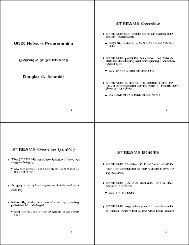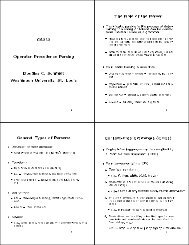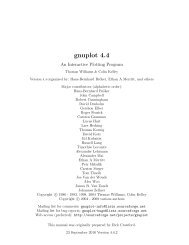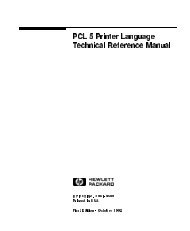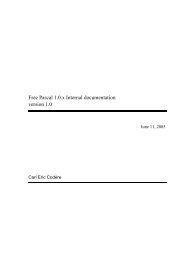The Orbix Architecture - Distributed Object Computing (DOC) group
The Orbix Architecture - Distributed Object Computing (DOC) group
The Orbix Architecture - Distributed Object Computing (DOC) group
You also want an ePaper? Increase the reach of your titles
YUMPU automatically turns print PDFs into web optimized ePapers that Google loves.
Coupling with a threads package is a special case of the filter mechanism. <strong>Orbix</strong> is notdelivered integrated with a threads package, because we envisaged that some applicationsmay not wish to use threads at all, and for those that do there may be several possibilitiesincluding SunOs lwp, Solaris 2.2 threads and Microsoft NT threads. A filter can however bewritten to catch all incoming requests into a process context and dispatch each on a newthread. <strong>The</strong> creating thread returns from the filter, with the request event apparentlysuppressed: the new thread continues with the request, applying the remaining filters (if any)in the filter chain, and then calling the target object.As described above, filtering is a per-process level mechanism, and applies (transparently) toall requests and replies leaving and entering a process context. We have also seen how smartproxies can transparently mediate client requests. <strong>Orbix</strong> provides a second form of filteringwhich complements smart proxies and operates within servers.Per-object filtering is a mechanism for providing a filter chain attached to a specific objectinstance (within a server). <strong>The</strong> chain can operate independently of other server objects. Aper-object filter chain is applied after the per-process filter chain, in the case of an incomingrequest, and before the per-process chain when the reply (if any) to that request is formed.A further distinction from per-process filtering is that at the time a per-object filter chain isapplied, the actual parameters (if any) to the specific operation have been unmarshalled andare available to the filter code. <strong>The</strong> filter code in effect is thus another implementation of theIDL interface associated with the target object: the filter code has methods for each of theIDL operations for the target object. Once again, a filter can choose to suppress the event,and so a per-object filter might choose not to pass the request through to its target object andinstead, perhaps, generate an exception.Per-object filtering can have similar uses to smart proxies, including assistance in debugging,auditing, and legacy applications. However a further use is to be able to transparentlypropagate a server event across a collection of objects, where such a collection cantransparently change. A "move" operation on a graphical object described in IDL could, forexample, be notified to a set of attached graphical objects, so that the entire aggregate ismoved in unison.<strong>Orbix</strong> <strong>Architecture</strong> - <strong>The</strong> <strong>Object</strong> Fault Handler<strong>Orbix</strong> does not have any direct support for handling persistent objects - that is, objects whosestate can be saved and restored from non-volatile storage. Some of the IONA team in facthave had very considerable experience in building distributed and persistent object systems,based on our earlier work in various ESPRIT projects and other research. However, whenbuilding <strong>Orbix</strong> and in keeping with our themes of simplicity, flexibility and elegance, we wereconvinced that it would be unwise to ship <strong>Orbix</strong> with a tightly coupled persistent store, whichcould adversely affect performance and cost. In addition, no single approach or persistentstore would be likely to suit all applications.info@iona.ie Page 11



